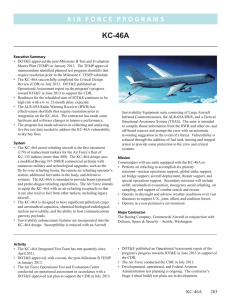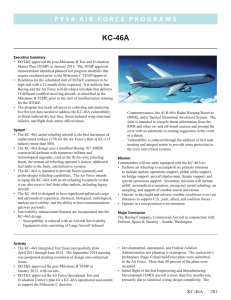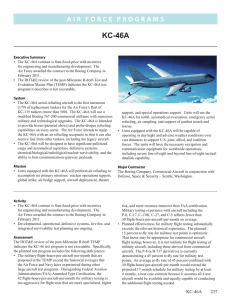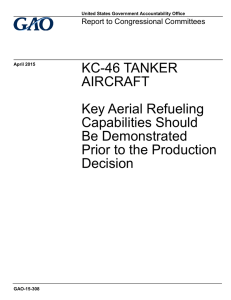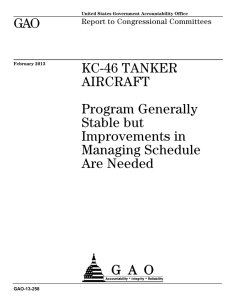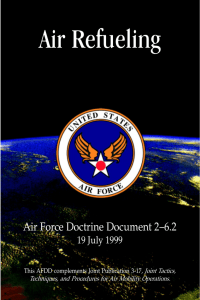KC-46A A i r F o r c e ...
advertisement
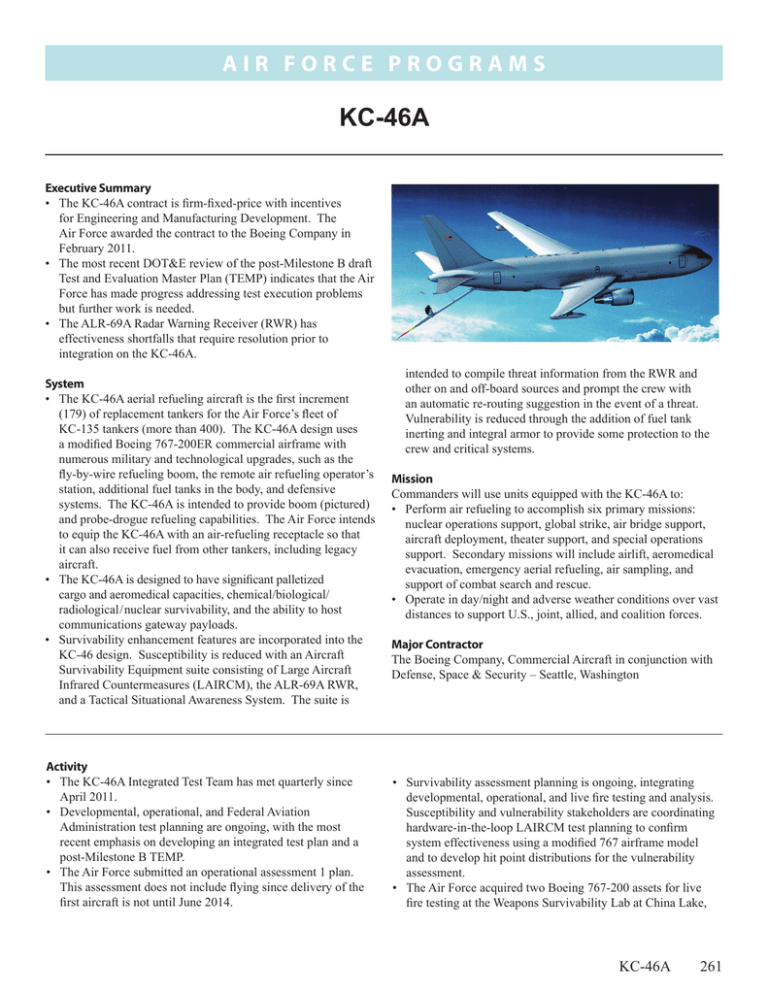
A i r F o r c e P RO G R A M S KC-46A Executive Summary • The KC-46A contract is firm-fixed-price with incentives for Engineering and Manufacturing Development. The Air Force awarded the contract to the Boeing Company in February 2011. • The most recent DOT&E review of the post-Milestone B draft Test and Evaluation Master Plan (TEMP) indicates that the Air Force has made progress addressing test execution problems but further work is needed. • The ALR-69A Radar Warning Receiver (RWR) has effectiveness shortfalls that require resolution prior to integration on the KC-46A. System • The KC-46A aerial refueling aircraft is the first increment (179) of replacement tankers for the Air Force’s fleet of KC-135 tankers (more than 400). The KC-46A design uses a modified Boeing 767-200ER commercial airframe with numerous military and technological upgrades, such as the fly-by-wire refueling boom, the remote air refueling operator’s station, additional fuel tanks in the body, and defensive systems. The KC-46A is intended to provide boom (pictured) and probe-drogue refueling capabilities. The Air Force intends to equip the KC-46A with an air-refueling receptacle so that it can also receive fuel from other tankers, including legacy aircraft. • The KC-46A is designed to have significant palletized cargo and aeromedical capacities, chemical/biological/ radiological / nuclear survivability, and the ability to host communications gateway payloads. • Survivability enhancement features are incorporated into the KC-46 design. Susceptibility is reduced with an Aircraft Survivability Equipment suite consisting of Large Aircraft Infrared Countermeasures (LAIRCM), the ALR-69A RWR, and a Tactical Situational Awareness System. The suite is Activity • The KC-46A Integrated Test Team has met quarterly since April 2011. • Developmental, operational, and Federal Aviation Administration test planning are ongoing, with the most recent emphasis on developing an integrated test plan and a post‑Milestone B TEMP. • The Air Force submitted an operational assessment 1 plan. This assessment does not include flying since delivery of the first aircraft is not until June 2014. intended to compile threat information from the RWR and other on and off-board sources and prompt the crew with an automatic re-routing suggestion in the event of a threat. Vulnerability is reduced through the addition of fuel tank inerting and integral armor to provide some protection to the crew and critical systems. Mission Commanders will use units equipped with the KC-46A to: • Perform air refueling to accomplish six primary missions: nuclear operations support, global strike, air bridge support, aircraft deployment, theater support, and special operations support. Secondary missions will include airlift, aeromedical evacuation, emergency aerial refueling, air sampling, and support of combat search and rescue. • Operate in day/night and adverse weather conditions over vast distances to support U.S., joint, allied, and coalition forces. Major Contractor The Boeing Company, Commercial Aircraft in conjunction with Defense, Space & Security – Seattle, Washington • Survivability assessment planning is ongoing, integrating developmental, operational, and live fire testing and analysis. Susceptibility and vulnerability stakeholders are coordinating hardware-in-the-loop LAIRCM test planning to confirm system effectiveness using a modified 767 airframe model and to develop hit point distributions for the vulnerability assessment. • The Air Force acquired two Boeing 767-200 assets for live fire testing at the Weapons Survivability Lab at China Lake, KC-46A 261 A i r F o r c e P RO G R A M S California. The Air Force developed a comprehensive live fire test plan and began the ballistic test program in FY12 with two test series: - A replica wing dry bay fire test series, completed in FY12 at Wright-Patterson AFB, Ohio, as part of a risk reduction effort to characterize various threats against KC-46 production materials - Wing dry bay fire testing on a 767-200 production asset, which began on schedule in 3QFY12. Assessment • The most recent DOT&E review of the post-Milestone B draft TEMP indicates that the Air Force has made progress addressing test execution problems but further work is needed. • The draft TEMP now allocates 5.5 months and 750 hours for operational testing, which is adequate for an effectiveness evaluation. To assess suitability, a statistically significant evaluation (at a 76 percent confidence) requires 1,250 flight hours; IOT&E may have to be extended to generate the required 1,250 flight hours if operationally representative field flight data are not available from other sources. • The planned test program includes the following shortfalls that have been partially addressed but require complete resolution to gain DOT&E approval: - Concurrent activities and planned flying hours for the Engineering, Manufacturing, and Development program place a high demand on limited aircraft and simulator resources. - The planned effectiveness for military flight testing substantially exceeds the relevant historical experience. The planned 75 percent test effectiveness rate for military test points is not consistent with experience for flight testing of military aircraft. An average historical test effectiveness rate of 55 percent combined with 30 flight‑hours-per-aircraft-per-month would extend the current 16-month schedule for military testing by approximately 4 – 7 months, a best-case estimate. - The Test Program Schedule in the draft TEMP has insufficient calendar time allotted for correction of discrepancies and/or deficiencies discovered during developmental testing prior to the planned start of operational testing. 262 KC-46A - The draft TEMP allocates insufficient resources (time and aircraft) for the initial training of aircrews and maintainers and technical order verification. Additional training time between the end of developmental test and the start of IOT&E is required. • The susceptibility assessment will focus on LAIRCM effectiveness and situational awareness provided by the RWR and Tactical Situational Awareness System. Since the majority of data for the evaluation of susceptibility will come from contractor and developmental testing, and this testing is governed by the firm-fixed-price contract, increases in the scope of testing identified by DOT&E may require additional funding. The building block design of experiments approach taken for dry bay fire testing will provide a method for wing leading and trailing edge damage prediction that should be useful for reducing uncertainty in the model-based vulnerability assessment. • The ALR-69A RWR was selected as Contractor Furnished Equipment by Boeing; however, integration and performance on the KC-46A are high risk. DOT&E recently completed an assessment of the ALR-69A RWR on the C-130H1 and assessed it as not effective, but suitable, in a separate classified report dated October 22, 2012. Not only do these effectiveness problems require correction, but the system is required to improve its geo-location capabilities as compared to the demonstrated C-130J capability. Recommendations • Status of Previous Recommendations. The Air Force has addressed some of the FY11 recommendations to submit a TEMP incorporating realistic assumptions; however, additional work is needed. • FY12 Recommendations. The Air Force should: 1. Submit a TEMP with a realistic schedule mitigating the above mentioned shortfalls. 2. Correct ALR-69A shortfalls prior to integration on the KC-46A. 3. Plan to begin IOT&E at least six months later than the current draft TEMP indicates to allow for completion of developmental test and initial training.
